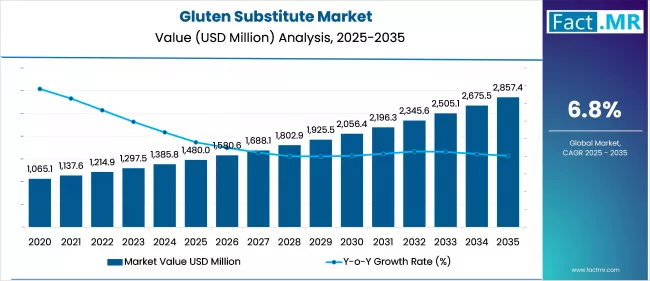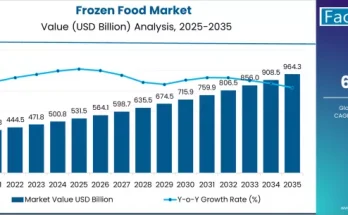The global gluten substitute market is experiencing remarkable growth as consumer demand for gluten-free foods rises worldwide. Gluten substitutes, including xanthan gum, guar gum, psyllium husks, chia seeds, and other innovative ingredients, provide alternatives that replicate the texture, elasticity, and binding properties of gluten. This growing market is driven by the increasing prevalence of gluten intolerance, celiac disease, and a broader trend toward health-conscious eating habits.
Market Overview
Gluten substitutes are essential in food formulation for bakery products, confectioneries, dairy, and cereals, among others. They enable manufacturers to produce gluten-free options without compromising taste, texture, or shelf life. The market spans multiple product types and forms, from organic to conventional, catering to diverse consumer preferences.
The rise in health awareness, coupled with the expansion of gluten-free diets, has encouraged food manufacturers to innovate with substitutes that improve sensory qualities, nutritional value, and overall product appeal. Moreover, regulatory guidelines emphasizing transparency in food labeling have fueled adoption, as consumers increasingly scrutinize ingredients.
Regional Insights
- North America: Leads the market due to high gluten-free awareness, extensive product availability, and strong retail penetration.
- Europe: Witnessing steady growth owing to increasing health consciousness, stringent food labeling regulations, and the popularity of organic and natural products.
- Asia-Pacific: Emerging as a high-potential market driven by urbanization, rising disposable income, and the expanding food processing industry.
- Latin America and Middle East & Africa: Gradual growth supported by rising consumer awareness and expansion of the bakery and confectionery sectors.
Key Trends & Forecast
- Innovation in Product Formulation: Manufacturers are focusing on enhancing the binding and textural properties of gluten substitutes to improve consumer experience.
- Organic and Clean Label Products: Consumer preference for organic, non-GMO, and natural ingredients is driving growth in organic gluten substitutes.
- Expansion in Food & Beverage Applications: Bakery, confectionery, cereals, dairy, and ready-to-eat foods are key areas where gluten substitutes are increasingly used.
- E-Commerce Growth: Online retail channels are gaining prominence due to convenience, a wider range of products, and global accessibility.
- Sustainability and Ethical Sourcing: Companies are increasingly sourcing ingredients responsibly to meet consumer demand for environmentally conscious products.
Applications & End-Use Outlook
Gluten substitutes are widely used across multiple sectors:
- Food & Beverage: Dominates the market with applications in bakery products, confectioneries, cereals, dairy products, and functional foods.
- Personal Care: Used in formulations such as cosmetics and skincare products to enhance texture and stability.
- Other Applications: Includes pet food, nutritional supplements, and industrial uses where gluten-free alternatives are preferred.
The bakery and confectionery segment continues to lead demand, driven by rising gluten-free consumption and increased retail penetration of gluten-free snacks and desserts.
Market Segmentation
By Type
- Xanthan Gum: Widely used as a thickener and stabilizer in bakery and dairy products.
- Guar Gum: Popular for its binding properties and ability to improve product texture.
- Psyllium Husks: Offers fiber enrichment and textural benefits in gluten-free formulations.
- Chia Seeds: Increasingly used for their nutritional value and functional properties.
- Others: Include innovative hydrocolloids and plant-based alternatives providing gluten-like properties.
By Nature
- Organic: Gaining popularity due to health-conscious consumers seeking clean-label products.
- Conventional: Standard substitutes widely used in commercial food production.
By End-Use
- Food & Beverage: Main application sector, with bakery, confectionery, dairy, cereals, and ready-to-eat foods.
- Personal Care: Use in cosmetics and skincare formulations.
- Others: Nutritional supplements and industrial applications.
By Region
- North America: Market leader with widespread adoption and high consumer awareness.
- Europe: Strong demand due to regulatory frameworks and preference for organic options.
- Asia-Pacific: Rapidly growing market driven by new manufacturers and rising bakery and food service sectors.
- Latin America and Middle East & Africa: Gradual expansion supported by increased consumer knowledge of gluten intolerance.
Drivers of Growth
- Rising Prevalence of Gluten Intolerance and Celiac Disease: Increasing health concerns encourage consumers to opt for gluten-free products.
- Health-Conscious Lifestyles: Greater focus on functional foods and wellness-oriented diets fuels demand.
- Expansion of Bakery and Confectionery Industries: Rising consumption of baked goods worldwide supports the use of gluten substitutes.
- Regulatory Compliance and Transparent Labeling: Stringent guidelines in food labeling increase consumer trust and boost market growth.
- Organic and Natural Ingredients Trend: Consumer preference for organic gluten-free products is driving innovation in substitute formulations.
Challenges & Restraints
- Price Sensitivity: Premium costs of high-quality gluten substitutes can limit widespread adoption.
- Formulation Complexity: Achieving desirable texture, taste, and consistency without gluten remains challenging.
- Consumer Education: Lack of awareness regarding gluten intolerance and substitute benefits can restrict market expansion.
- Market Fragmentation: Presence of numerous small manufacturers creates intense competition and price pressures.
Competitive Landscape
Key players in the gluten substitute market focus on innovation, strategic partnerships, and market expansion. Leading companies include Cargill, ADM, Danisco, DSM, CP Kelco, DowDuPont, Fufeng Group, Ingredion, Deosen Biochemical, and Jungbunzlauer. Strategies include:
- Product Innovation: Launching new gluten substitutes with improved binding, texture, and nutritional profiles.
- Market Expansion: Entering emerging regions and strengthening distribution channels.
- Quality Assurance: Ensuring consistent product performance and certification to build consumer trust.
- Sustainability Initiatives: Using responsibly sourced ingredients and eco-friendly packaging to meet consumer expectations.
Future Outlook
Over the next decade, the gluten substitute market is expected to witness:
- Steady Growth Across Segments: Food & beverage applications, particularly bakery and confectionery, will continue to dominate.
- Rising Organic Adoption: Organic gluten substitutes will gain traction as consumer preference for clean-label products increases.
- Innovation in Functional Ingredients: Development of novel hydrocolloids and plant-based alternatives to improve gluten-free product quality.
- E-Commerce Expansion: Online retail channels will play a key role in reaching wider consumer bases.
- Emerging Market Opportunities: Asia-Pacific and South America are likely to experience strong growth due to rising bakery and food processing industries.
Conclusion
The global gluten substitute market is rapidly transforming the food industry, enabling manufacturers to meet growing consumer demand for gluten-free products without compromising on quality or taste. Rising health awareness, expansion in bakery and confectionery sectors, and regulatory support for transparent labeling are driving sustained market growth.
Gluten substitutes are essential in addressing dietary restrictions and promoting wellness-oriented consumption. As the market evolves, innovation, organic ingredient adoption, and sustainability initiatives will be key differentiators for leading brands. With continued growth expected across regions and applications, the gluten substitute market is poised to shape the future of gluten-free foods and functional ingredients.
Browse Full Report – https://www.factmr.com/report/4240/gluten-substitute-market



